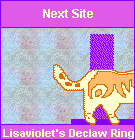
The British Veterinary Association calls declawing "an unnecessary mutilation" (2). Indeed it is illegal in Germany (3) and other parts of Europe (4)
Declawing a cat involves general anesthesia and amputation of the last joint of each toe, including the bones, not just the nail. Possible complications of this surgery include:- reaction to anesthetic, (5) hemorrhage, bone chips, which prevent healing, recurrent infections and damage to the radial nerve, pain, and possible abnormal regrowth of the nails (6) the nails may grow back inside the paw, causing pain, but remaining invisible to the eye. Declawed cats will need regular xrays to monitor this problem. Declawing results in a gradual weakening of leg, shoulder and back muscles, and, because of impaired balance, declawed cats have to relearn to walk, much as would a person who has lost their toes. Without claws, cats are virtually defenseless, and this often leads to neurosis and even skin and bladder problems.
Animal protection groups, including the American Humane Association and the Humane Society OF the United States, as well as many other verterinarians have spoken out against declawing. Many vets refuse to perform the surgery, calling the operation cruel, and in most cases unnecessary. Veterinarian Florence Barton says, "I won't perform this operation. The cat is missing (his or her) most important means of defense and...feels very insecure" (7). In "The Cat Care Question and Answer Book" verterinarian Barry Bush concurs: "veterinary removal of the claws (onychectomy) is a painful mutilation which cannot be recommended under any circumstances" (8) Dr. Louis J. Comuti, a practicing vet for more than 58 years sums up his objections this way "I wouldn't declaw a cat if you paid me $ 1000 per nail!" (9)
Without claws to mark their territory, even house-trained cats will often urinate and defecate outside the litter box, in a desperate attempt to ward off intruders (10)
There are several misconceptions about declawing. It does not make cats more "mellow". Declawed cats may be morose, reclusive or withdrawn, or they may be irritable, aggressive and unpredictable. Many people think that declawing makes a cat safer around babies, but this is far from true, as the lack of claws turns many cats into biters. Declawed cats feel so insecure, lacking their first line of defense that they tend to bite more often as a means of self protection (11).
People who have their cats declawed simply do not understand how important claws are to a cat, and do not know how else to deal with the problem. With a little effort and committment to your cat's welfare, you can eliminate the excuse to declaw your cat, and make you and them better companions as well.

otherwise cats may get frustrated and revert back to using furniture.
Play games with your cat on and around the post, and attach hanging objects and toys to it. Sprinkle catnip on the post too (a once-a-week or so "refresher" application will keep your cat interested) When kitty uses the post, reinforce this behaviour with praise, but be careful not to startle or frighten him or her.
When the cat claws furniture, discourage this behaviour with a firm voice or other loud noise, but never with physical force. Lukewarm water from a squirt gun, directed at the back of the animal is often successful. During the training period you may eed to cover upholstery with plastic or other protection 9cats don't like the slippery feel and will quickly learn to stay away. (12)
just my own opinion
Treat your cat with the same principles as a child, care for them, love them, spend time with them, take the time to teach them what is acceptable and what isn't, and you will have very few problems. If they do claw or damage something, keep in mind that they are animals, and that instinct and behaviour are a part of the package. Accept them, and love them for what they are, after all, that's what they do with you. People NEVER have the right to mutilate any animal for "convenience".
By understanding cat behviour and by using common-sense precautions and behaviour modification methods, you can prevent clawing damage without inflicting pain on your feline companion.
-----------------------------------------------------------------------------
(1) Townsend, Jean B., "How to Deal With Your Cat's Claws", Maryland Feline Society, Inc., 1982.
(2) Marsden, Donna, "Cats With Claws: It's Only Natural", Washington Humane Society News, Spring 1995, page 3.
(3) Riddle, Roz, "The City Cat ", Charles Scribner Sons, 1984, page 40.
(4) "Place For Cats", New York, N.Y., 1993.
(5) Wilbourne, Carol C., "Cats Prefer It This Way", Coward, Mcann and Geoghegan, 1976.
(6) Townsend, op cit.
(7) Barton, Florence, D.V.M., "Ask The Vet ", Cat Fancy
(8) "Declawing: Convenient But Cruel ?", PAWS News, Feb., 1989.
(9) "Paws Come With Claws", Friends Of Animals Brochure.
(10)Ibid
(11)Ibid
(12)Ibid



 | Educate!! Don't Amputate!! site owned by PJ and The Pud. Click here to join the ring |  |
[PREV 5 SITES | RANDOM SITE | SITELIST | NEXT 5 SITES]
